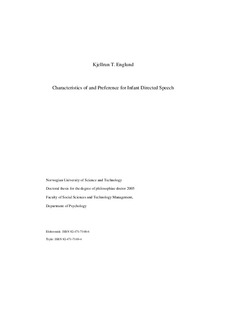| dc.description.abstract | Infant directed speech (IDS) has different characteristics than adult directed speech (ADS). Studies of acoustic-phonetic aspects of IDS show, by measures of the first two formant frequencies, that vowels have more extreme articulations in IDS than ADS (Burnham, Kitamura & Vollmer-Conna, 2002; Kuhl, Andruski, Chistovich, Chistovich, Kozhevnikova, Ryskina, Stolyarova, Sundberg, Lacerda, 1997; Bernstein Ratner, 1984). Research has shown that stop consonants are articulated with a shorter VOT in IDSt han in ADS (Sundberg & Lacerda, 1999; Malsheen, 1980). In addition, Sundberg (1998) propose that IDS contains adaptations to the infant’s development. An experimental setting may not convey natural IDS. In addition, no studies have been made of the acoustic-phonetic content of Norwegian IDS. In a longitudinal production study using a natural interactive setting with 10 recordings per infant over a period of six months, recordings were made of mothers alone with their infants (IDS) and in adult conversations (ADS). Both to accommodate the families that participated in the study and to secure a natural setting for the productions, both IDS and ADS recordings were made in the participants’ homes. An IDS recording was typically made in the bathroom when the mother changed infants’ nappies and a typical ADS recording was made in the living room during a conversation between the mother and the experimenter. From words within these productions, segments were selected from both ADS and IDS recordings at each point in time, and acoustic analyses carried out for the vowels /a:/, /i:/ and /u:/, and their short counterparts /a/ /i/ and /u/, the voiced stop consonants /b/, /d/, /g/ and the voiceless /p/, /t/, /k/, as well as for the fricative /s/. Statistical analyses were based both on data for each segment that was merged across time points and on analyses of the change in acoustic-phonetic attributes of segments between different points in time.
Repeated measures analyses show Norwegian IDS from a natural setting to be different than results from comparable previous research. In Norwegian IDS, formant frequencies in back vowels show that articulation of the back vowels /a:/, /a/, /u:/ and /u/ are articulated more front compared to ADS, while the front vowel quality /i:/-/i/ does not differ between speech types. For vowels, only the difference in duration between IDS and ADS changed over time, but duration was nonetheless longer in IDS than ADS throughout the six months. In addition, also contrary to previous research (Sundberg & Lacerda, 1999), voice onset time (VOT) in Norwegian IDS is longer than in ADS for alveolar and velar voiced and unvoiced stops as well as an unvoiced bilabial stop, but the voiced bilabial stop /p/ has a similar VOT across speech types.
The results from the production study show that Norwegian IDS is different from Norwegian ADS, possibly corresponding to an enhancement of speech to infants. Further, in addition to enhancing auditory cues to the infant, IDS could contain specifications that also enhance visual cues to the infant.
To address this as a possible explanation for the results from Norwegian IDS, a perception study was carried out with 23 infants from 2-8 months old. Infants’ perception of audio-visually matching (congruent) or audio-visually mismatching (incongruent) syllables in ADS and IDS was tested to see whether the possible visual enhancement in IDS is important for perception of audio-visual processing. Enabling testing of infants in their homes, an adapted method with a visual fixation task was used. To obtain visual fixation time, infants were video-recorded while they were watching a video where a woman was speaking to her infant and to an adult. She articulated the CV-syllables (/pi:/, /pa:/ and /pu:/). The syllables were analysed acoustically to ensure that the vowels /a:, i:, and u:/ had the same formant frequencies for F1, F2 and F3 as the mean formant frequencies resulting from the production study. An auditory syllable (/pa:/) was either paired with the corresponding visual syllable (/pa:/) or one of the other visual syllables (/pi:/ or /pu:/) produced in the same speech type. This audio-visual matching was done for both ADS and IDS. Infants watched the resulting eighteen trials, and their visual fixation time was logged. Results from a repeated measures analysis showed that infants from 2 to 8 months old looked longer at IDS than ADS but unexpectedly longer at incongruent than congruent syllables in the study. While it is uncertain why incongruent syllables are preferred to congruent syllables, infants possibly prefer audio-visual IDS to ADS due to both auditory and visual characteristics of IDS vowels. By investigating production and perception of IDS in natural settings, the current research may be a step forth in uncovering how the characteristics of IDS may be connected to infants’ perception of speech. | nb_NO |
